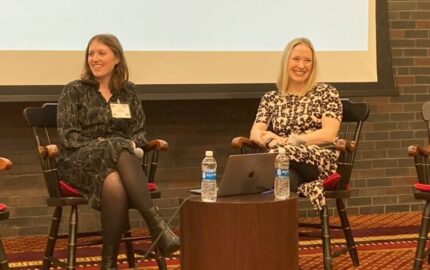
We spoke this week with Marie-Claude Dupont, producer of the GDP Project, an effort to document the economic crisis in Canada. Funded by the National Film Board, the project’s filmmakers track the lives of 15 Canadians for one year, while photographers simultaneously collect images and audio from around over the country. Dupont, who has worked with online content for more than a decade, has been a writer, researcher, radio show host and journalist, as well as co-producer of Contact and the contacttv.net site, a documentary series featuring biographical portraits of prominent thinkers and artists. Here she talks with us about the challenge of coordinating a vast documentary Web project, the unpredictable nature of “narrative on the fly,” and the effort “to invent a new language” through various platforms and digital media.
Exactly what is the GDP project?
Traditional documentaries are meant to be broadcast on TV or seen in theaters—but in this case, the project is built around a Web experience. The GDP project is the first bilingual pan-Canadian Web documentary project of the National Film Board of Canada. It was initiated in December 2008 by Monique Simard, the head of the French programming board here at the NFB, along with her counterpart of the NFB English programming, Cindy Witten.
They decided to do something about the economic crisis, because they felt that it was an issue not only for Canada but in America and worldwide. They thought it was a great opportunity for the NFB to document what is happening to Canadians as they live through the current economic crisis.
In a traditional approach, you would send filmmakers across Canada. They would shoot and bring back footage, and then they would go in the editing rooms, and maybe two years later, they would present something to represent the big picture of the economic crisis. In our case, we wanted to present this material while people are still struggling with the economic crisis—that’s why we chose the Web platform for this project.
It reminds me in some ways of a multimedia version of the 20th-century Farm Security Administration photography in the United States. What do you see as your inspiration or guiding projects?
The guiding project was a French documentary, Gaza Sderot , by UPIAN, a film that features Israelis and Palestinians. It was done a few years ago and was a great inspiration to those working in documentary film. On the Web site you can see that that there is a clear metaphor for life over there: the screen is divided in two—on the left side you have the Israeli, and on the right side you have the Palestinian. There were filmmakers on the road capturing how these two peoples were very close but very apart.
That was the inspiration, but our project is a little more extensive because we have 12 filmmakers and 12 photographers across Canada. We’ve chosen two types of media for our project. We are following 15 characters from areas that have been touched by the economic crisis in Canada. The project was launched in September 2009. We’re following them on a monthly or bimonthly basis until the end of the project, which will be in August 2010.
In addition to our main characters, we also have photographers in areas where we cannot find filmmakers on a regular basis, and they meet the communities and find characters who are struggling and who are facing realities of the crisis. They shoot photographs and capture audio excerpts, and these will become short documentary films based on the photographs.
Right now, we have more than 110 short films and photo essays—which is about 7 ½ hours of material—on the Web site.
The site says that you’re documenting how people across the country are managing in the dark days of the economic crisis. On a creative level, though, it seems like you’re trying to create a new approach to multimedia documentary.
It’s a very big challenge for us, because we’re trying to show how these people reinvent themselves, how they fight for their future while there is an economic crisis. Sometimes it’s not a sexy topic. We wish to show how great we can be in these difficult times.
Right now the media are talking about percentages, numbers, GDP, how the real estate market is doing—things that are not directly about the human side of the economic crisis. We’re aiming to reveal this human side. The fact that we’re following characters helps us do that. We have some stories that are doing very well in the sense that there is a lot going on in the lives of our characters. In some others, the narrative is slow, because what’s happening takes a long, long time. At the same time, you have also the Web documentary project, which is not the same on any day you visit. You have Canadians posting photos, video, text comments. It’s an evolving process.
What we want to show at the end is one year during the economic crisis, and you will have 14 hours of documentary film, and we will have le témoignage, a kind of witnessing of what’s happened in this critical and historical time period.
How did you choose the stories to focus on?
We had a bunch of researchers working very closely with the head director-coordinator, Hélène Choquette, who is a documentary filmmaker and did the main research herself.
We then hired a few filmmakers with whom we worked to discover who would be the most promising characters for our project. The stories had to be linked with the economic crisis and some of the sectors we wanted to cover, because not all the sectors of the economy have been touched the same way. So we gave the filmmakers research days to go to communities and find people, to go to cafés, visit associations and organizations, and find the characters we would like to follow for a year.
We have an artist in Windsor, the southern part of Ontario close to Detroit. He decided to move to Toronto and start over again at 40 years old. You have farmers, people who work in companies that have shut down. They have to start over again. You also have young entrepreneurs who have experienced big drops in their revenues over the year. You have community workers who help families feed their children—all kinds of people.
It’s an entirely digital project. They have their cameras, but there are no cassettes—it’s all on cards and it’s sent through FTP and then we edit all the pieces here in Montreal with the director-coordinator. The filmmakers are in contact with the characters on a weekly basis, but they usually do one piece a month.
It seems like you’re focusing on people who are middle class, people who had work but have fallen in some way specifically due to the economic crisis. Did you think of looking at the crisis’ effect on the very poor—addicts or the homeless, communities like that?
You have the structural poverty, those who have always been poor, and they are still poor. We do feature homeless people—a guy who had a job and lost it, living in the street with his 16-year-old girl. He’s Francophone, and they’re in Vancouver. Because our topic is the economic crisis, it’s not about those who have been poor for 10 or 20 years, but we do have people who have recently become very poor in there.
What kind of response have you gotten? How many people have visited the site? How many people have participated by posting material or comments?
Right now, we have almost 50,000 unique visitors. What makes this project so powerful is that you have several stories and they’re living together in one place at the same time. You can browse and see what’s happening in the western part of Canada, what’s happening in the east. Some of the stories we have seven or eight episodes.
We wanted to reach this richness of content before doing a formal launch, but in the meantime, we have done outreach to let the related organizations and local media know about the existence of our project. We have more than 250 comments on the Web site. We have people following us on Facebook and Twitter. The work that we’ve done behind the scenes is starting to pay off, because every week, we’re gaining more followers.
Because it’s the economic crisis, some people may think we only have only sad stories, which is not the case. We have a young lady who is in her 20s. She decided that since she didn’t have any job, over the course of the year, she would do 100 jobs for $100 each. She’s doing all kinds of stuff—being a model, washing floors, whatever. We’re showing people who are taking advantage of opportunities in real estate or finance. We have two traders from Bay Street in Toronto that we’ve followed since September.
You can also subscribe to receive alerts once a new episode is posted on the Website, and we have an interactive map. The green dots are user-generated content. If you go back in time, you can see that in the beginning, there was only a little response, but now it’s getting bigger each week.
What do you hope this will do in the long run? Will you make a more traditional film out of this—or will it be only on the Web?
It’s possible that we will do a film. It would be the reverse situation. Normally you would do a documentary, and then you would do something as a compliment on the Web. By the end of August, we want to complete more than 220 pieces on the Web site. Then it’s going to go into archive mode, but people will be able to post their own content or add their own voice to the project for a while.
I don’t know if you know about David Lynch’s “Interview Project.” They went to some areas in the United States and filmed. Once they were done, they posted it on the Web site. One character, one shot, one area. In our case, we don’t know what’s going to happen. It’s very challenging to us on the production side. We have all those people working for us out in the field, but we have to edit the film and make sure it stands as a relevant episode in the series. Some event might not happen or could go wrong, and then we have to plan ahead for the next series of episodes. To some extent, comments could also have some influence on where the stories go.
This is the interesting part from a narrative standpoint, because there are things that might change a lot from one month to another. We’re experimenting with narrative on the fly. It also brings challenges from a technical standpoint, because we have people who are shooting differently. They have their own way of working with the characters, but it has to be part of the bigger picture.
The people shooting in the field don’t edit their own work, right?
It’s new for the filmmakers to do that as well. It’s going to be edited in Montreal, but we rely on the strength of each filmmaker to think ahead what may happen to this person to bring out the best of the event he’s going to shoot. They are not just in the field to execute. It’s really a work of art for them, but at the same time, it’s part of a bigger project that keeps the big picture in mind.
You could say it’s a cross-platform project. We’re on Facebook and Twitter. We also have links in iPhone. We’ll have some films on the Rogers Web portal in Canada. It’s done differently depending on the platform. You may not find the same collection of material everywhere.
Do you see this as journalism?
There’s a frontier between documentary and journalism. We’re clearly documentary. In some cases, because we’re linked with the economic crisis, there’s complimentary information that we post on the Website that’s more journalistic. Frankly, we’re trying to allow these people to speak for themselves and not judge them. It’s the characters that are put up front. We're reinterpreting the reality through the lens of our filmmakers.
The project is government funded, right?
Yes. The National Film Board is a federal agency here in Canada. What we do mainly is to produce films, and coproduce with other countries, too, mainly documentary films, some fiction films and a lot of animated films, but the GDP Project is our first experience with this kind of effort. We’re not saying we’re the best, or that we’re the ultimate experience, but we’re learning a lot, and that’s why we find it so exciting. It changes every day.
[For more information, read our Storyboard post on the GDP Project.]


